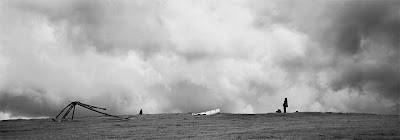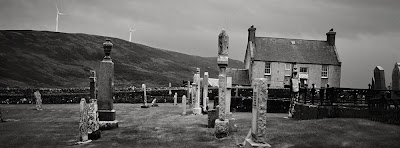Jay Tyrrell
When I was a child, I watched the original Godzilla movie way too many times. Afterwards, I’d look out our living room window, out at the California mountains and the Hollywood sign, and think I could hear the warning wail of Godzilla. In my imagination, he was ready to rear-up over the Hollywood sign and devastate my neighborhood. It was one of my early childhood worries and today, I still am not a fan of reptiles. The fact that this memory is so clear makes me realize how the early imprints of visual and audible stimulation form who we are today.
Jay Tyrrell comes to his wonderful project, Wind Army, with a similar set of early childhood influences. In particular, it was War of the Worlds that sparked a love of science fiction and an ability to see the world in a unique way. With this series, he takes a look at structures perceived as one way, and he brings his own sci-fi interpretation of that world. He’s a cinematographer at heart. A long time California photographer now living in Napa, Jay has created an iTunes app of Wind Army, will open a solo exhibition of this project at the Santa Barbara Museum of Art in December, and is also selling his book, Weather, through the Wall Space Gallery in Santa Barbara.
Wind Army: I suppose growing up I read too many science fiction stories. Sure, I had my share of Christopher Robin and Superheroes of all disguises and abilities, but it was the Utopian worlds with light from two suns and aliens who could read your thoughts that captured my imagination. Do you Grok?
Begging my mother and accompanied by my younger sister, we took in War of the Worlds that fall of 1953. How was a young mind going to settle for Huckleberry Finn after that? I read all the boys classics but soon my shelf was full of Isaac Asimov, Arthur C. Clarke, Robert Heinlein and others that wrote of ideal societies and strange life forms that could beam across light years. It was a necessary diversion in a time when school had mandatory nuclear attack drills. My love of Science Fiction was born, all started by the now classic story of alien invasion in War of the Worlds. Of all the stories, this is the one that took captive my imagination. The original story of Earth being invaded by forces from another planet is for me where Science Fiction was born.
The Paramount Pictures movie that so frightened and thrilled me was just one of several media events inspired by this timeless story. A radio play that caused a panic in the Eastern United States before the network could explain that it was a Halloween trick-or-treat? Wow, now that’s a powerful story. Orson Welles’ 1938 radio script cowritten by Howard Koch proved it, and changed history.
By the time the television series as a sequel to War of the Worlds 1953 movie appeared, I had seen 2001: A Space Odyssey five or six times, trying to decipher the meaning of the Obelisk and lining up for hours to be the first to see Star Wars and buy a light saber. The Twilight Zone and Star Trek had become television history. “Beam me up Scotty” was now part of the lexicon.
So it came as no surprise that the first wind farm I saw didn’t make me think of alternative sources of energy but that the Tripods of War of the Worlds had come alive and were marching across the landscape. As I passed these monoliths I would see their alien shapes rotating in the light, beckoning me to stop and let my imagination run free – to begin an exploration and retelling of this classic story.
Proceeding with this project, as I traveled and added images to this body of work, reviewed it, showed it and learned from those experiences, I realized how big the story was in my life and what an opportunity I had to learn from it. So I added researcher to the hats I was wearing, and began to look back at the over 100 years of influence this story has had on media and storytelling and, when viewed through the lens of history, how significant it is and how the dust of what’s new has dulled our appreciation.
H.G.Wells, called “The Man Who Invented Tomorrow”, originally published this novel in 1898 and it is considered by many to be the birth of Science Fiction. What I find interesting is that this story has been at the vortex of creative uses of new media, first in radio, then movies and comics, and eventually television. Each time this story appeared in its new form, it has been a sensation and set the standard for others to follow.
I now have the opportunity to bring War of the Worlds to yet another media, combining elements from all that went before with
my photographs of landscapes and abstract forms into a new type of book to pay homage to this story that so shaped my childhood fantasies. This project has taken me ever deeper into an appreciation of the power of this story and its timeless themes and how it’s uniquely served as the catalyst at the birthplace of Science Fiction storytelling in so many forms. I wonder what the future will bring.
Posts on Lenscratch may not be reproduced without the permission of the Lenscratch staff and the photographer.
Recommended
-
Tara Sellios: Ask Now the BeastsApril 6th, 2024
-
ALEXIS MARTINO: The Collapsing Panorama April 4th, 2024
-
Emilio Rojas: On Gloria Anzaldúa’s Borderlands: The New MestizaMarch 30th, 2024
-
Artists of Türkiye: Eren SulamaciMarch 27th, 2024
-
Love and Loss in the Cosmos: Valeria Sestua In Conversation with Vicente IsaíasMarch 19th, 2024









































































